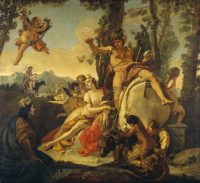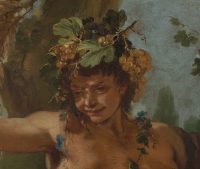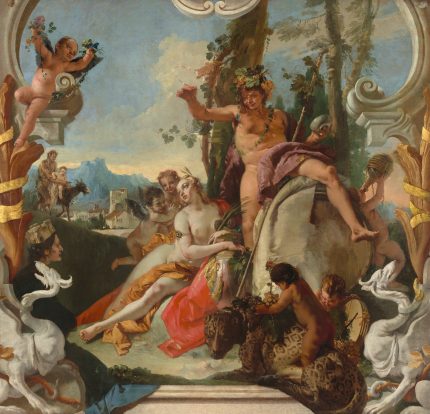 Bacchus and Ariadne (1743/1745), a monumental oil-on-canvas painting by Giovanni Battista Tiepolo, is back on display at Washington’s National Gallery of Art after a four-year conservation. The painting is believed to be part of a series of mythological scenes representing the four elements: earth, water, air and fire, only three of which are known to survive today. Bacchus and Ariadne represented earth.
Bacchus and Ariadne (1743/1745), a monumental oil-on-canvas painting by Giovanni Battista Tiepolo, is back on display at Washington’s National Gallery of Art after a four-year conservation. The painting is believed to be part of a series of mythological scenes representing the four elements: earth, water, air and fire, only three of which are known to survive today. Bacchus and Ariadne represented earth.
We know from a letter Tieopolo wrote in 1764 that he painted the series to adorn a Venice palace. We don’t know which palace as the only reference in the letter to the owner are the initials “V.E.” Bacchus and Ariadne only decorated V.E.’s palace for 60 years or so before it was bought by a collector and moved out of Venice for good. The meticulous restoration has revealed long-lost original details that were painted over when the work was first moved at the end of the 18th century or lost as the condition deteriorated over time.
The project’s painting conservator, Sarah Gowen Murray, worked closely with colleagues in painting conservation, scientific research, and preventive conservation to treat the painting and conduct analysis of the work. Overpaint removal uncovered tall vertical leaves on the left and right sides of the composition. Infrared imaging—conducted by John Delaney, senior imaging scientist—and analysis of cross-section samples of those areas—examined and interpreted by Barbara Berrie, head of the scientific research department—indicated that the leaves were originally bound together by gold ribbons. A precedent for the ribbons was established in another work by Tiepolo, Castigo dei Serpenti (The Scourge of the Snakes) (1732–1735) at the Gallerie dell’Accademia in Venice. These findings, archived documentation images, and other works by the artist were then consulted to reconstruct the missing elements with inpainting.
Other discoveries made during the treatment include indications of significant compositional changes made by Tiepolo, suggesting that Bacchus and Ariadne may have been the first painting of the series. X-radiographs exposed curved forms at the lower-right corner extending beneath the griffin and the jaguar—perhaps initial attempts by the artist to incorporate the composition into the work’s surrounding architecture.
 One characteristic feature of Tieopolo’s mature works that has been brought back to life with this restoration is the coolness of his color palette. This set him apart from other Venetian painters of his period and allowed his frescoes and large-scale paintings like this one to convey a realistic sense of daylight. The illumination effect would have been a particularly desirable feature in monumental works intended to decorate the walls of large palaces. Bacchus and Ariadne, for example, were commissioned to hang over a staircase.
One characteristic feature of Tieopolo’s mature works that has been brought back to life with this restoration is the coolness of his color palette. This set him apart from other Venetian painters of his period and allowed his frescoes and large-scale paintings like this one to convey a realistic sense of daylight. The illumination effect would have been a particularly desirable feature in monumental works intended to decorate the walls of large palaces. Bacchus and Ariadne, for example, were commissioned to hang over a staircase.
X-rays have found that there was a ledge painted along the bottom edge with griffin-like creatures at each end of the ledge. A cornice framed the top of the painting as well, curving down. The right side had a column with a vine of acanthus leaves wrapped around it. These architectural features are thought to have been created to match the location where the painting was originally located. They were painted over, likely after the work was acquired by the Artaria family who hung it in their Como estate. Inventory records note its presence there in 1798. The ledge, columns and griffins were painted out and a figure of Rhea was added to the lower left of the composition. The conservation restored the architectural elements, doubtless much to the relief of the putto on the top left who now has his perch back instead of floating unmoored.
The X-rays also found a great deal of damage to the canvas itself — tears, holes — and areas of inpainting and overpainting from later interventions that were not well done to begin with and had discolored and flaked over the years. The varnish was even worse. Darkened and discolored, the varnish layers had mutated the cool daylight palette of the original to a bilious jaundice. A full relining of the canvas and careful thinning of the varnish layers performed in 1960 was unable to solve the problem, but conservation technology has changed enormously over the past 60 years. The recent treatment has brought back Tieopolo’s light blue sky.

Apparently I embody the way mass public tastes have shifted since this painting was made, because to me it is hideous, from the pretentiously faux “classical” conceit of the subject matter to details like the cherub at upper left who looks like a balding, flabby, leering old man. I do appreciate that it has been preserved and partially revived with great effort and skill and that there are many who savor its aesthetics. But to me, it’s ugly and depressing and has none of the uplifting power of great art. Guess I’m a Philistine.
Still an interesting post. I may not like the art itself, but its history and restoration are interesting. Thanks for writing about it.
It is indeed all a matter of taste. But here the solution is rather simple: The “cherub” in the upper left is in fact a “satyr”, a member of a troop of –more (or in this case less)– ithyphallic male companions of Dionysus. He is supposed to look like a “balding, flabby, leering old man”. Notably, not all of them look like “cherubs”, as often they only do look like “balding, flabby, leering old men”. The one behind that stone, for example, is boozing himself away. Of course, we cannot say what the orgies of the original owner of that painting did look like.
However, “when Theseus abandoned Ariadne sleeping on Naxos, Dionysus found and married her. She bore him a son named Oenopion, but he committed suicide or was killed by Perseus. In some variants, he had her crown put into the heavens as the constellation Corona; in others, he descended into Hades to restore her to the gods on Olympus. Another different account claims Dionysus ordered Theseus to abandon Ariadne on the island of Naxos for he had seen her as Theseus carried her onto the ship and had decided to marry her.”
:hattip:
Well, I only embody myself, and as an abstract artist this is far from my interest, but I still see it as an excellent piece, and in my eyes it makes more sense following its restoration.
It must have looked amazing in its original setting, but I wonder if the background is generic or represents the original owner’s country estate?
It is gloriously tacky! I can see why someone did away with the griffins and architectural elements, yikes. The gallery REALLY needs to hang this where visitors will come upon it suddenly, so all can enjoy their startled reactions.
Gallery?!? 😆 …–With– “griffins and architectural elements”, I have seen those pieces already at the bishop’s rather modest townhouse:
“The staircase of the Würzburg Residence spans its vault, 18 × 32 meters, without pillars. Beneath an unsupported trough vault, a masterpiece of construction with a maximum height of 23 meters.
When guests approached, the vast ceiling fresco above was increasingly revealed to them. This fresco, the largest in the world [?], created from 1750-3 by Venetian painter Giovanni Battista Tiepolo shows paintings of the four continents: Europe, America, Asia and Africa.
Each continent is represented by a typical landscape and animals (or the painter’s vision of these animals) and a female allegorical figure.”
I feel the “cherub” in the upper left is Eros because he holds in his right hand the rose, his emblem. I am some what confused as to the kneeling figure of Tyche with her crown on the lower left. Is it her presence as “luck” or “fortune” that things have turned out ok for poor Ariadne?